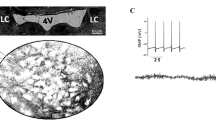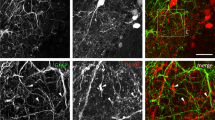Abstract
Orexins, novel excitatory neuropeptides from the lateral hypothalamus, have been strongly implicated in the regulation of sleep and wakefulness. In this study, we explored the effects and mechanisms of orexin A on intracellular free Ca2+ concentration ([Ca2+]i) of freshly dissociated neurons from layers V and VI in prefrontal cortex (PFC). Changes in [Ca2+]i were measured with fluo-4/AM using confocal laser scanning microscopy. The results revealed that application of orexin A (0.1 ≈1 μM) induced increase of [Ca2+]i in a dose-dependent manner. This elevation of [Ca2+]i was completely blocked by pretreatment with selective orexin receptor 1 antagonist SB 334867. While depletion of intracellular Ca2+ stores by the endoplasmic reticulum inhibitor thapsigargin (2 μM), [Ca2+]i in PFC neurons showed no increase in response to orexin A. Under extracellular Ca2+-free condition, orexin A failed to induce any changes of Ca2+ fluorescence intensity in these acutely dissociated cells. Our data further demonstrated that the orexin A-induced increase of [Ca2+]i was completely abolished by the inhibition of intracellular protein kinase C or phospholipase C activities using specific inhibitors, BIS II (1 μM) and D609 (10 μM), respectively. Selective blockade of L-type Ca2+ channels by nifedipine (5 μM) significantly suppressed the elevation of [Ca2+]i induced by orexin A. Therefore, these findings suggest that exposure to orexin A could induce increase of [Ca2+]i in neurons from deep layers of PFC, which depends on extracellular Ca2+ influx via L-type Ca2+ channels through activation of intracellular PLC-PKC signaling pathway by binding orexin receptor 1.
Similar content being viewed by others
References
Ammoun, S., Johansson, L., Ekholm, M.E., Holmqvist, T., Danis, A.S., Korhonen, L., Sergeeva, O.A., Haas, H.L., Akerman, K.E. Kukkonen, J.P. (2006): OX1 orexin receptors activate extracellular signal-regulated kinase in Chinese hamster ovary cells via multiple mechanisms: the role of Ca2+ influx in OX1 receptor signaling.Mol Endocrinol,20, 80–99.
Bayer, L., Serafin, M., Eggermann, E., Saint-Mleux, B., Machard, D., Jones, B.E. Muhlethaler, M. (2004): Exclusive postsynaptic action of hypocretin-orexin on sublayer 6b cortical neurons.J Neurosci,24, 6760–6764.
Burdakov, D., Liss, B. Ashcroft, F.M. (2003): Orexin excites GABAergic neurons of the arcuate nucleus by activating the sodium—calcium exchanger.J Neurosci,23, 4951–4957.
Chen, C. Xu, R. (2003): The in vitro regulation of growth hormone secretion by orexins.Endocrine,22, 57–66.
Chen, X.W., Mu, Y., Huang, H.P., Guo, N., Zhang, B., Fan, S.Y., Xiong, J.X., Wang, S.R., Xiong, W., Huang, W., Liu, T., Zheng, L.H., Zhang, C.X., Li, L.H., Yu, Z.P., Hu, Z.A. Zhou, Z. (2008): Hypocretin-1 potentiates NMDA receptor-mediated somatodendritic secretion from locus ceruleus neurons.J Neurosci,28, 3202–3208.
Davis, P.D., Hill, C.H., Lawton, G., Nixon, J.S., Wilkinson, S.E., Hurst, S.A., Keech, E. Turner, S.E. (1992): Inhibitors of protein kinase C. 1. 2,3-Bisarylmaleimides.J Med Chem,35, 177–184.
De Lecea, L., Kilduff, T.S., Peyron, C., Gao, X., Foye, P.E., Danielson, P.E., Fukuhara, C., Battenberg, E.L., Gautvik, V.T., Bartlett, F.S., 2nd, Frankel, W.N., van den Pol, A.N., Bloom, F.E., Gautvik, K.M. Sutcliffe, J.G. (1998): The hypocretins: hypothalamus-specific peptides with neuroexcitatory activity.Proc Natl Acad Sci U S A,95, 322–327.
Ekholm, M.E., Johansson, L. Kukkonen, J.P. (2007): IP3-independent signalling of OX1 orexin/ hypocretin receptors to Ca2+ influx and ERK.Biochem Biophys Res Commun,353, 475–480.
Eriksson, K.S., Sergeeva, O., Brown, R.E. Haas, H.L. (2001): Orexin/hypocretin excites the histaminergic neurons of the tuberomammillary nucleus.J Neurosci,21, 9273–9279.
Holmqvist, T., Akerman, K.E. Kukkonen, J.P. (2002): Orexin signaling in recombinant neuronlike cells.FEBS Lett,526, 11–14.
Ishibashi, M., Takano, S., Yanagida, H., Takatsuna, M., Nakajima, K., Oomura, Y., Wayner, M.J. Sasaki, K. (2005): Effects of orexins/hypocretins on neuronal activity in the paraventricular nucleus of the thalamus in rats in vitro.Peptides,26, 471–481.
Johansson, L., Ekholm, M.E. Kukkonen, J.P. (2008): Multiple phospholipase activation by OX(1) orexin/hypocretin receptors.Cell Mol Life Sci,65, 1948–1956.
Johansson, L., Ekholm, M.E. Kukkonen, J.P. (2007): Regulation of OX1 orexin/hypocretin receptor-coupling to phospholipase C by Ca2+ influx.Br J Pharmacol,150, 97–104.
Kohlmeier, K.A., Inoue, T. Leonard, C.S. (2004): Hypocretin/orexin peptide signaling in the ascending arousal system: elevation of intracellular calcium in the mouse dorsal raphe and laterodorsal tegmentum.J Neurophysiol,92, 221–235.
Kohlmeier, K.A., Watanabe, S., Tyler, C.J., Burlet, S. Leonard, C.S. (2008): Dual orexin actions on dorsal raphe and laterodorsal tegmentum neurons: noisy cation current activation and selective enhancement of Ca2+ transients mediated by L-type calcium channels.J Neurophysiol,100, 2265–2281.
Kukkonen, J.P. Akerman, K.E. (2001): Orexin receptors couple to Ca2+ channels different from store-operated Ca2+ channels.Neuroreport,12, 2017–2020.
Lambe, E.K. Aghajanian, G.K. (2003): Hypocretin (orexin) induces calcium transients in single spines postsynaptic to identified thalamocortical boutons in prefrontal slice.Neuron,40, 139–150.
Larsson, K.P., Akerman, K.E., Magga, J., Uotila, S., Kukkonen, J.P., Nasman, J. Herzig, K.H. (2003): The STC-1 cells express functional orexin-A receptors coupled to CCK release.Biochem Biophys Res Commun,309, 209–216.
Larsson, K.P., Peltonen, H.M., Bart, G., Louhivuori, L.M., Penttonen, A., Antikainen, M., Kukkonen, J.P. Akerman, K.E. (2005): Orexin-A-induced Ca2+ entry: evidence for involvement of trpc channels and protein kinase C regulation.J Biol Chem,280, 1771–1781.
Lund, P.E., Shariatmadari, R., Uustare, A., Detheux, M., Parmentier, M., Kukkonen, J.P. Akerman, K.E. (2000): The orexin OX1 receptor activates a novel Ca2+ influx pathway necessary for coupling to phospholipase C.J Biol Chem,275, 30806–30812.
Magga, J., Bart, G., Oker-Blom, C., Kukkonen, J.P., Akerman, K.E. Nasman, J. (2006): Agonist potency differentiates G protein activation and Ca2+ signalling by the orexin receptor type 1.Biochem Pharmacol,71, 827–836.
Muroya, S., Funahashi, H., Yamanaka, A., Kohno, D., Uramura, K., Nambu, T., Shibahara, M., Kuramochi, M., Takigawa, M., Yanagisawa, M., Sakurai, T., Shioda, S. Yada, T. (2004): Orexins (hypocretins) directly interact with neuropeptide Y, POMC and glucose-responsive neurons to regulate Ca2+ signaling in a reciprocal manner to leptin: orexigenic neuronal pathways in the mediobasal hypothalamus.Eur J Neurosci,19, 1524–1534.
Narita, M., Nagumo, Y., Miyatake, M., Ikegami, D., Kurahashi, K. Suzuki, T. (2007): Implication of protein kinase C in the orexin-induced elevation of extracellular dopamine levels and its rewarding effect.Eur J Neurosci,25, 1537–1545.
Nasman, J., Bart, G., Larsson, K., Louhivuori, L., Peltonen, H. Akerman, K.E. (2006): The orexin OX1 receptor regulates Ca2+ entry via diacylglycerol-activated channels in differentiated neuroblastoma cells.J Neurosci,26, 10658–10666.
Sakurai, T., Amemiya, A., Ishii, M., Matsuzaki, I., Chemelli, R.M., Tanaka, H., Williams, S.C., Richardson, J.A., Kozlowski, G.P., Wilson, S., Arch, J.R., Buckingham, R.E., Haynes, A.C., Carr, S.A., Annan, R.S., McNulty, D.E., Liu, W.S., Terrett, J.A., Elshourbagy, N.A., Bergsma, D.J. Yanagisawa, M. (1998): Orexins and orexin receptors: a family of hypothalamic neuropeptides and G protein-coupled receptors that regulate feeding behavior.Cell,92, 573–585.
Saper, C.B., Scammell, T.E. Lu, J. (2005): Hypothalamic regulation of sleep and circadian rhythms.Nature,437, 1257–1263.
Smart, D., Jerman, J.C., Brough, S.J., Rushton, S.L., Murdock, P.R., Jewitt, F., Elshourbagy, N.A., Ellis, C.E., Middlemiss, D.N. Brown, F. (1999): Characterization of recombinant human orexin receptor pharmacology in a Chinese hamster ovary cell-line using FLIPR.Br J Pharmacol,128, 1–3.
Smart, D., Sabido-David, C., Brough, S.J., Jewitt, F., Johns, A., Porter, R.A. Jerman, J.C. (2001): SB-334867-A: the first selective orexin-1 receptor antagonist.Br J Pharmacol,132, 1179–1182.
Song, C.H., Chen, X.W., Xia, J.X., Yu, Z.P. Hu, Z.A. (2006): Modulatory effects of hypocretin-1/orexin-A with glutamate and gammaaminobutyric acid on freshly isolated pyramidal neurons from the rat prefrontal cortex.Neurosci Lett,399, 101–105.
Song, C.H., Xia, J.X., Ye, J.N., Chen, X.W., Zhang, C.Q., Gao, E.Q. Hu, Z.A. (2005): Signaling pathways of hypocretin-1 actions on pyramidal neurons in the rat prefrontal cortex.Neuroreport,16, 1529–1533.
Toullec, D., Pianetti, P., Coste, H., Bellevergue, P., Grand-Perret, T., Ajakane, M., Baudet, V., Boissin, P., Boursier, E., Loriolle, F.et al. (1991): The bisindolylmaleimide GF 109203X is a potent and selective inhibitor of protein kinase C.J Biol Chem,266, 15771–15781.
Trivedi, P., Yu, H., MacNeil, D.J., Van der Ploeg, L.H. Guan, X.M. 1998): Distribution of orexin receptor mRNA in the rat brain.FEBS Lett,438, 71–75.
Uramura, K., Funahashi, H., Muroya, S., Shioda, S., Takigawa, M. Yada, T. (2001): Orexin-a activates phospholipase C- and protein kinase Cmediated Ca2+ signaling in dopamine neurons of the ventral tegmental area.Neuroreport,12, 1885–1889.
Van den Pol, A.N., Gao, X.B., Obrietan, K., Kilduff, T.S. Belousov, A.B. (1998): Presynaptic and postsynaptic actions and modulation of neuroendocrine neurons by a new hypothalamic peptide, hypocretin/orexin.J Neurosci,18, 7962–7971.
Wu, M., Zaborszky, L., Hajszan, T., van den Pol, A.N. Alreja, M. (2004): Hypocretin/orexin innervation and excitation of identified septohippocampal cholinergic neurons.J Neurosci,24, 3527–3536.
Xia, J., Chen, X., Song, C., Ye, J., Yu, Z. Hu, Z. (2005): Postsynaptic excitation of prefrontal cortical pyramidal neurons by hypocretin-1/orexin A through the inhibition of potassium currents.J Neurosci Res,82, 729–736.
Xia, J.X., Chen, X.W., Cheng, S.Y. Hu, Z.A. (2005): Mechanisms of orexin A-evoked changes of intracellular calcium in primary cultured cortical neurons.Neuroreport,16, 783–786.
Xu, R., Roh, S.G., Gong, C., Hernandez, M., Ueta, Y. Chen, C. (2003): Orexin-B augments voltage-gated L-type Ca(2+) current via protein kinase C-mediated signalling pathway in ovine somatotropes.Neuroendocrinology,77, 141–152.
Xu, R., Wang, Q., Yan, M., Hernandez, M., Gong, C., Boon, W.C., Murata, Y., Ueta, Y. Chen, C. (2002): Orexin-A augments voltagegated Ca2+ currents and synergistically increases growth hormone (GH) secretion with GHreleasing hormone in primary cultured ovine somatotropes.Endocrinology,143, 4609–4619.
Yamasaki, H., LaBar, K.S. McCarthy, G. (2002): Dissociable prefrontal brain systems for attention and emotion.Proc Natl Acad Sci U S A,99, 11447–11451.
Ye, J.H. Akaike, N. (1993): Calcium currents in pyramidal neurons acutely dissociated from the rat frontal cortex: a study by the nystatin perforated patch technique.Brain Res,606, 111–117.
Zhu, Y., Miwa, Y., Yamanaka, A., Yada, T., Shibahara, M., Abe, Y., Sakurai, T. Goto, K. (2003): Orexin receptor type-1 couples exclusively to pertussis toxin-insensitive G-proteins, while orexin receptor type-2 couples to both pertussis toxin-sensitive and -insensitive G-proteins.J Pharmacol Sci,92, 259–266.
Author information
Authors and Affiliations
Corresponding author
Rights and permissions
About this article
Cite this article
Xia, J.X., Fan, S.Y., Yan, J. et al. Orexin A-induced extracellular calcium influx in prefrontal cortex neurons involves L-type calcium channels. J Physiol Biochem 65, 125–136 (2009). https://doi.org/10.1007/BF03179063
Received:
Issue Date:
DOI: https://doi.org/10.1007/BF03179063




